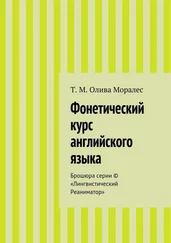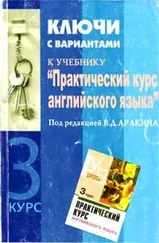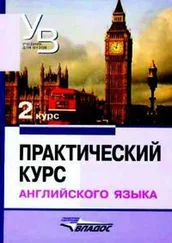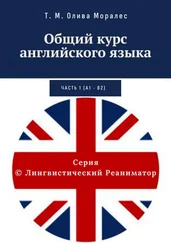Владимир Аракин - Практический курс английского языка 3 курс [calibre 2.43.0]
Здесь есть возможность читать онлайн «Владимир Аракин - Практический курс английского языка 3 курс [calibre 2.43.0]» весь текст электронной книги совершенно бесплатно (целиком полную версию без сокращений). В некоторых случаях можно слушать аудио, скачать через торрент в формате fb2 и присутствует краткое содержание. Год выпуска: 2006, Издательство: ВЛАДОС, Жанр: tbg_higher, на русском языке. Описание произведения, (предисловие) а так же отзывы посетителей доступны на портале библиотеки ЛибКат.
- Название:Практический курс английского языка 3 курс [calibre 2.43.0]
- Автор:
- Издательство:ВЛАДОС
- Жанр:
- Год:2006
- ISBN:нет данных
- Рейтинг книги:2.5 / 5. Голосов: 2
-
Избранное:Добавить в избранное
- Отзывы:
-
Ваша оценка:
- 60
- 1
- 2
- 3
- 4
- 5
Практический курс английского языка 3 курс [calibre 2.43.0]: краткое содержание, описание и аннотация
Предлагаем к чтению аннотацию, описание, краткое содержание или предисловие (зависит от того, что написал сам автор книги «Практический курс английского языка 3 курс [calibre 2.43.0]»). Если вы не нашли необходимую информацию о книге — напишите в комментариях, мы постараемся отыскать её.
I - V курсов педагогических вузов.
Цель учебника – обучение устной речи на основе развития необходимых автоматизированных речевых навыков, развитие техники чтения, а также навыков письменной речи.
Практический курс английского языка 3 курс [calibre 2.43.0] — читать онлайн бесплатно полную книгу (весь текст) целиком
Ниже представлен текст книги, разбитый по страницам. Система сохранения места последней прочитанной страницы, позволяет с удобством читать онлайн бесплатно книгу «Практический курс английского языка 3 курс [calibre 2.43.0]», без необходимости каждый раз заново искать на чём Вы остановились. Поставьте закладку, и сможете в любой момент перейти на страницу, на которой закончили чтение.
Интервал:
Закладка:
^
PAINTING
Topical Vocabulary
1. Painters and their craft:a fashionable/self-taught/mature artist, a portrait/landscape painter, to paint from nature/memory/
imagination, to paint mythological/historical subjects, to specialize in portraiture/still life, to portray people/emotions with moving
sincerity/with restraint, to depict a person/a scene of common life/the mood of..., to render/interpret the personality of..., to reveal the
person's nature, to capture the sitter's vitality/transient expression, to develop one's own style of painting; to conform to the taste of
the period, to break with the tradition, to be in advance of one's time, to expose the dark sides of life, to become famous overnight, to
die forgotten and penniless.
2. Paintings. Genres:an oil painting, a canvas, a water-colour/ pastel picture; a sketch/study; a family group/ceremonial/inti-
mate portrait, a self-portrait, a shoulder/length/half-length/knee- length/full-length portrait; a landscape, a seascape, a genre/his torical
painting, a still life, a battle piece, a flower piece, a masterpiece.
3. Composition and drawing:in the foreground/background, in the top/bottom/left-hand corner; to arrange symmetrically/asym-
metrically/in a pyramid/in a vertical format; to divide the picture space diagonally, to define the nearer figures more sharply, to em -
phasize contours purposely, to be scarcely discernible, to convey a sense of space, to place the figures against the landscape back -
ground, to merge into a single entity, to blend with the landscape, to indicate the sitter's profession, to be represented standing.../sit-
ting.../talking..., to be posed/ silhouetted against an open sky/a classic pillar/the snow; to accentuate smth.
4. Colouring. Light and shade effects:subtle/gaudy colouring, to combine form and colour into harmonious unity; brilliant/low-
keyed colour scheme, the colour scheme where ... predominate; muted in colour; the colours may be cool and restful/hot and agi-
tated/soft and delicate/dull, oppressive, harsh; the delicacy of tones may be lost in a reproduction.
5. Impression. Judgement:the picture may be moving, lyrical, romantic, original, poetic in tone and atmosphere, an exquisite
piece of painting, an unsurpassed masterpiece, distinguished by a marvellous sense of colour and composition.
The picture may be dull, crude, chaotic, a colourless daub of paint, obscure and unintelligible, gaudy, depressing, disappoint ing,
cheap and vulgar.
1. Read the following text for obtaining its information:
Thomas Gainsborough was born in Sudbury, Suffolk, in 1727, the son of John Gainsborough, a cloth merchant. He soon evinced a
marked inclination for drawing and in 1740 his father sent him to London to study art. He stayed in London for eight years, working
under the rococo portrait-engraver Gravelot; he also became familiar with the Flemish tradition of painting, which was highly prized
by London art dealers at that time. "Road through Wood, with Boy Resting and Dog", 1747 is a typical 'genre painting', obviously in-
fluenced by Ruisdael. In Many aspects this work recalls Constable's "Cornfield".
In 1750 Gainsborough moved to Ipswich where his professional career began in earnest. He executed a great many small-sized
portraits as well as landscapes of a decorative nature. In October 1759 Gainsborough moved to Bath. In Bath he became a much
sought-after and fashionable artist, portraying the aristocracy, wealthy merchants, artists and men of letters. He no longer produced
small paintings but, in the manner of Van Dyck, turned to full-length, life-size portraits. From 1774 to 1788 (the year of his death)
Gainsborough lived in London where he divided his time between portraits and pictorial compositions, inspired by Geior- gione,
which Reynolds defined as "fancy pictures" ("The Wood Gatherers", 1787). As a self-taught artist, he did not make the traditional
grand tour or the ritual journey to Italy, but relied on his own remarkable instinct in painting.
Gainsborough is famous for the elegance of his portraits and his pictures of women in particular have an extreme delicacy and re-
finement. As a colourist he has had few rivals among English painters. His best works have those delicate brush strokes which are
found in Rubens and Renoir. They are painted in clear and transparent tone, in a colour scheme where blue and green predominate.
The particular discovery of Gainsborough was the creation of a form of art in which the sitters and the background merge into a
single entity. The landscape is not kept in the background, but in most cases man and nature are fused in a single whole through the
atmospheric harmony of mood; he emphasized that the natural background for his characters neither was, nor ought to be, the
drawing-room or a reconstruction of historical events, but the changeable and harmonious manifestations of nature, as revealed both
in the fleeting moment and in the slowly evolving seasons. In the portrait of "Robert Andrews and Mary, His Wife", for example, the
beauty of the green English summer is communicated to the viewer through the sense of well-being and delight which the at-
mosphere visibly creates in the sitters. Gainsborough shows the pleasure of resting on a rustic bench in the cool shade of an oak tree,
while all around the ripe harvest throbs in a hot atmosphere enveloped by a golden light.
Emphasis is nearly always placed on the season in both the landscapes and the portraits, from the time of Gainsborough's ear ly
works until the years of his late maturity: from the burning summer sun in "Robert Andrews and Mary, His Wife" to the early autumn
scene in "The Market Cart", painted in 1786—1787, a work penetrated throughout by the richness and warmth of colour of the
season, by its scents of drenched earth and marshy undergrowth.
It is because his art does not easily fall within a well-defined theoretical system that it became a forerunner of the romantic move-
ment, with its feeling for nature and the uncertainty and anxiety experienced by sensitive men when confronted with nature: "Mary,
Countess Howe" (1765), "The Blue Boy" (1770), "Elizabeth and Mary Linley" (1772), "Mrs. Hamilton Nisbet" (1785).
The marriage portrait "The Morning Walk", painted in 1785, represents the perfection of Gainsborough's later style and goes
beyond portraiture to an ideal conception of dignity and grace in the harmony of landscape and figures.
Gainsborough neither had not desired pupils, but his art — ideologically and technically entirely different from that of his rival
Reynolds — had a considerable influence on the artists of the English school who followed him. The landscapes, especially those of
his late manner, anticipate Constable, the marine paintings, Turner. His output includes about eight hundred portraits and more than
two hundred landscapes.
2. Answer the following questions:
1. How did Gainsborough start his career? 2. What is known about the Ipswich period of his life? 3. What kind of practice did
Gainsborough acquire in Bath? 4. What is a self-taught artist? 5. What do you know about the Flemish tradition (school) of painting?
6. What contribution did Van Dyck make to the English school of painting? 7. What are Rubens and Renoir famous for? 8. Why did
Gainsborough place the sitter in direct contact with the landscape? 9. How is his conception of the relationship between man and
nature reflected in the portrait of "Robert Andrews and Mary, His Wife"? 10. What distinguishes "The Market Cart"? 11. What do
Читать дальшеИнтервал:
Закладка:
Похожие книги на «Практический курс английского языка 3 курс [calibre 2.43.0]»
Представляем Вашему вниманию похожие книги на «Практический курс английского языка 3 курс [calibre 2.43.0]» списком для выбора. Мы отобрали схожую по названию и смыслу литературу в надежде предоставить читателям больше вариантов отыскать новые, интересные, ещё непрочитанные произведения.
Обсуждение, отзывы о книге «Практический курс английского языка 3 курс [calibre 2.43.0]» и просто собственные мнения читателей. Оставьте ваши комментарии, напишите, что Вы думаете о произведении, его смысле или главных героях. Укажите что конкретно понравилось, а что нет, и почему Вы так считаете.
![Владимир Аракин Практический курс английского языка 3 курс [calibre 2.43.0] обложка книги](/books/402486/vladimir-arakin-prakticheskij-kurs-anglijskogo-yazyk-cover.webp)











